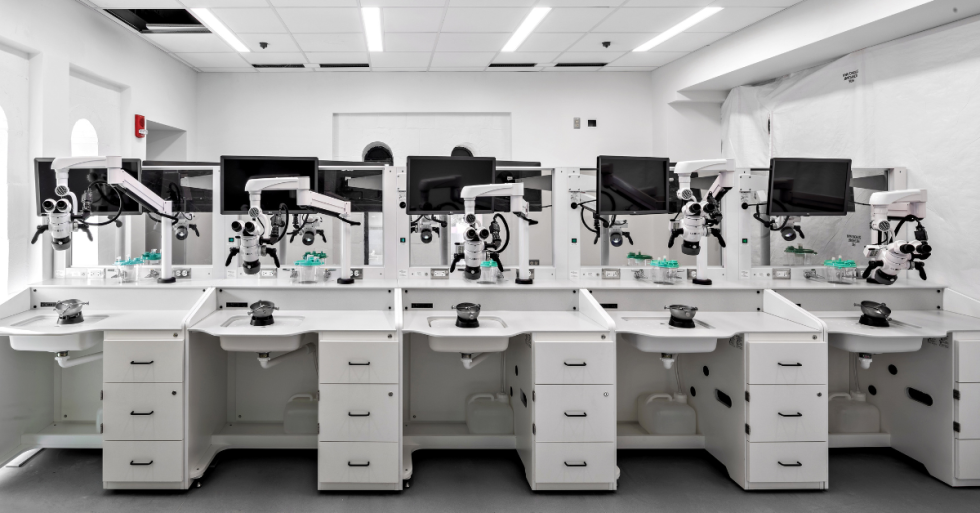The Role of Temporal Bone Labs in Medical ENT Training

When it comes to mastering the intricate art of ear surgery, there’s no substitute for hands-on experience. That’s where temporal bone labs come into play — they are becoming a more widely known and used piece of training equipment in otolaryngology and neurotology education.
These microsurgical labs provide a bridge between theoretical learning and real-world surgical proficiency. The lab is primarily used by medical students, residents, and practicing surgeons to learn and practice various ear surgeries, including cochlear implant placement, mastoidectomies, and other procedures related to hearing and balance.
Some labs are also used for research into new surgical techniques, technologies, and treatment modalities for conditions affecting the ear.
Here’s an inside look at the crucial role these labs play in the medical community.
The Anatomy of a Temporal Bone Lab
At the heart of every temporal bone lab is the commitment to replicating the operating room experience as closely as possible. The lab is equipped with numerous drill stations, each mirroring the surgical setup with high-fidelity instruments, including drills, suction equipment, and sophisticated microscopes. This setting allows practitioners to simulate procedures with an accuracy that theory alone could never achieve.
Features of a Temporal Bone Lab:
- Temporal Bone Specimens: Labs are often equipped with real or synthetic temporal bone specimens for dissection and practice.
- Microscopes: High-quality microscopes are essential for the delicate work required in ear surgery.
- Drill Stations: Each workstation is typically equipped with a drill and suction setup, similar to what surgeons would use in an actual operation.
- Audiovisual Equipment: To aid in teaching, many labs have cameras and screens to display the work being done at each station, allowing for live demonstrations and reviews.
- Safety Equipment: Proper ventilation and safety equipment are necessary to protect users from bone dust and noise generated during drilling.
- Instructors: Experienced surgeons and teachers oversee training, offering guidance and expertise to learners.
- Simulation Technology: Advanced labs may include virtual reality or computer-assisted simulation to complement hands-on training.
The Backbone of Otolaryngological Expertise
Temporal bone labs facilitate a deep understanding of the complex structures housed within the temporal bone, such as the cochlea, the vestibular system, and the facial nerve. By practicing on real or synthetic temporal bone specimens, medical professionals can hone their techniques, from the delicate removal of bone tissue to the precision placement of implants.
A Synergy of Technology and Technique
Modern temporal bone labs are often at the forefront of technological integration in surgical training. High-definition cameras and recording equipment allow trainees to review their procedures in detail, while virtual reality and computer simulations offer interactive learning experiences without the need for physical specimens.
Safety First
The significance of safety in such an environment cannot be overstressed. Given the generation of bone dust and the use of high-speed drills, the labs are designed with advanced ventilation systems and personal protective equipment to safeguard the health and well-being of all users.
A Legacy of Lifelong Learning
The temporal bone lab is more than just a training ground for new surgeons. It’s a place where seasoned professionals can refine existing techniques or explore new approaches. The dynamic nature of medical science means that even experienced surgeons return to the lab to keep their skills sharp and stay abreast of innovations in surgical methods.
Collaboration and Community
Beyond individual skill development, these labs often act as hubs of collaboration. Multidisciplinary teams, including audiologists, biomedical engineers, and neuroscientists, come together to push the boundaries of what’s possible in ear treatment and surgery.
Ready to Begin?
Ready to get your custom lab setup started? Global Surgical has worked with some of the world’s foremost medical institutions to build and install temporal bone, neurosurgical, dental, and multi-purpose microsurgical laboratories.
Reach the experts here at Global Surgical by calling us at 800-861-3585 or by clicking the button below. We can help you get a quote, timeline and anything else you need to get started.


.png)
.png)